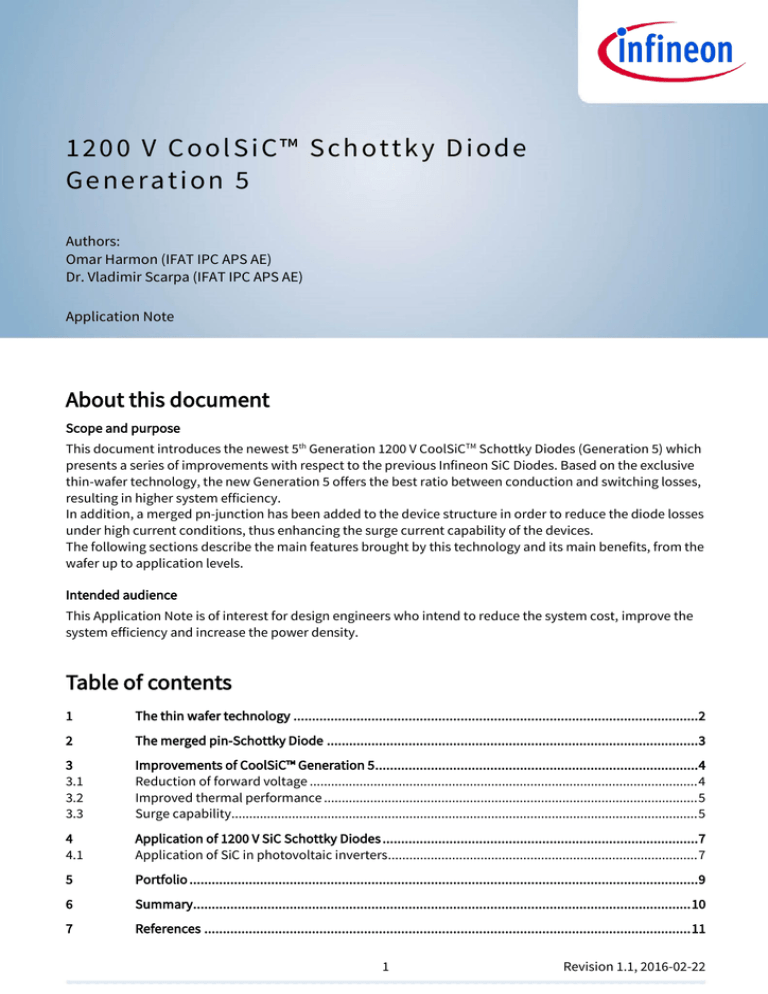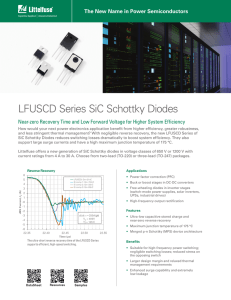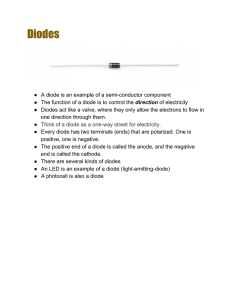
120 0 V Co o lSi C ™ S ch o ttk y D i od e
Gen era ti o n 5
Authors:
Omar Harmon (IFAT IPC APS AE)
Dr. Vladimir Scarpa (IFAT IPC APS AE)
Application Note
About this document
Scope and purpose
This document introduces the newest 5th Generation 1200 V CoolSiCTM Schottky Diodes (Generation 5) which
presents a series of improvements with respect to the previous Infineon SiC Diodes. Based on the exclusive
thin-wafer technology, the new Generation 5 offers the best ratio between conduction and switching losses,
resulting in higher system efficiency.
In addition, a merged pn-junction has been added to the device structure in order to reduce the diode losses
under high current conditions, thus enhancing the surge current capability of the devices.
The following sections describe the main features brought by this technology and its main benefits, from the
wafer up to application levels.
Intended audience
This Application Note is of interest for design engineers who intend to reduce the system cost, improve the
system efficiency and increase the power density.
Table of contents
1
The thin wafer technology ............................................................................................................. 2
2
The merged pin-Schottky Diode .................................................................................................... 3
3
3.1
3.2
3.3
Improvements of CoolSiC™ Generation 5 ....................................................................................... 4
Reduction of forward voltage ............................................................................................................. 4
Improved thermal performance ......................................................................................................... 5
Surge capability................................................................................................................................... 5
4
4.1
Application of 1200 V SiC Schottky Diodes ..................................................................................... 7
Application of SiC in photovoltaic inverters....................................................................................... 7
5
Portfolio ......................................................................................................................................... 9
6
Summary...................................................................................................................................... 10
7
References ................................................................................................................................... 11
1
Revision 1.1, 2016-02-22
1200 V CoolSiC™ SiC Schottky Diode Generation 5
The thin wafer technology
1
The thin wafer technology
Generation 5 SiC Diodes make use of Infineon’s exclusive thin-wafer technology. Here, the thickness of
substrate, the dominant factor in the overall diode resistance, is reduced to around 1/3 of the former 1200 V
SiC Diode technologies. As it is going to be explained in the following sections, this has a direct impact on
the forward voltage, as well as on thermal characteristics and surge current capability.
A schematic representation of a SiC Schottky Diode is shown Figure 1. Besides the bond metal and the
Schottky contact, two other layers are represented in Figure 1: The drift layer, which provides the blocking
capability during reverse voltage application, the SiC substrate which provides mechanical stability and the
backside metal. The merged pn junction, also present in Generation 5, is not represented in Figure 1 for
simplicity. It will be discussed in details in Section 2 of this document.
In Figure 1, the current flow direction during forward biased operation is from top to bottom. The SiC
substrate contributes to the electrical resistance, represented as Rbulk, which is the main contributor to the
diode’s differential resistance Rdiff. Reducing the substrate’s thickness reduces the diode’s overall resistance
thus lowering the forward voltage when the diode is conducting.
Moreover, as it is deeply analyzed in section 3.1, Generation 5 also presents a lower dependency of the
forward voltage on temperature.
Wire bond
bond metal
Schottky contact
Drift layer
Substrate thickness
Substrate thickness in Gen 5
SiC Substrate
in Gen 2
Rbulk
Backside metal
Figure 1
Schematic representation of a SiC Schottky Diode indicating thick and thin wafers. Merged pn
junction is not represented for simplicity.
Application Note
2
Revision 1.1, 2016-02-22
1200 V CoolSiC™ SiC Schottky Diode Generation 5
The merged pin-Schottky Diode
2
The merged pin-Schottky Diode
As mentioned in the former section, the Generation 5 structure also contains a merged pn-Schottky (MPS)
diode structure. The same concept is already present in 600 V SiC diodes since its 2nd Generation [6].
However this is the first time MPS is implemented in 1200 V SiC diodes. As displayed in Figure 2, the epitaxial
layer of the diode additionally contains p-doped regions labeled as p+. At low current densities, the current
flows through the Schottky regions, while surge current flows through the p-regions. Both paths for the
current flow are depicted in Figure 2.
For surge currents, for example the in-rush current to a capacitor during the turn-on of the system, the
p-regions become active and gives additional total current carrying capability. Additionally, this also leads
to a much lower overall voltage drop than in a common Schottky diode.
p-doped regions
Polyimide
p+
p+
p+
p+ p+ p+
surge current flow
current flow in normal operation
Termination
Epi Layer
Field Stop Layer
SiC Substrate
Backside Metal
Figure 2
SiC diode with MPS structure during normal and surge current operation
The right side of Figure 2 also presents the VF-IF characteristics of a Schottky and MPS diode during nominal
current and surge current. The combined VF-IF characteristic of the Schottky diode plus MPS results in the
lowest power losses, even at current levels well above the diode rated current. As a result, SiC diodes with
MPS can withstand a much higher surge current than conventional SiC-Schottky diodes. A quantified
evaluation of this benefit is presented in Section 3.3.
Application Note
3
Revision 1.1, 2016-02-22
1200 V CoolSiC™ SiC Schottky Diode Generation 5
Improvements of CoolSiC™ Generation 5
3
Improvements of CoolSiC™ Generation 5
This section summarizes the features introduced by the thin-wafer technology featuring MPS and quantifies
their benefits on the new Generation 5 SiC-diode devices.
3.1
Reduction of forward voltage
For a system to run in high efficiency, system power losses need to be minimized. Due to the absence of
reverse recovery charge, the conduction losses Pcond usually are the main source of losses in a SiC Schottky
diode. This contribution can be mathematically expressed to be:
(1)
𝑃𝑐𝑜𝑛𝑑 = 𝑉𝐹 ∙ 𝐼𝐹 ,
where IF is the current through the diode. Therefore, in order to lower conduction losses, the forward voltage
VF in conduction mode has to be reduced.
It is also important to understand that VF has two components: The threshold voltage Vth needed for the
diode to start conducting current and a differential resistance Rdiff, that represents the overall diode
resistance. The diode forward voltage can be approximated by:
(2)
𝑉𝐹 = 𝑉𝑡ℎ + (𝐼𝐹 ∙ 𝑅𝑑𝑖𝑓𝑓 )
Therefore, by reducing Rdiff, the diode’s conduction losses are lowered.
Figure 3 depicts the VF characteristic of a Generation 5 chip rated for 5 A, compared to a chip with the same
current rating from former Generation 2 from Infineon. At nominal current, the forward voltage of the
Generation 5 chip is measured to be 1.37 V in accordance to the nominal datasheet value VF=1.40 V at
Tj=25 °C.
For Generation 2, 1.74 V are measured, 21% higher than Generation 5. At Tj=175°C, the difference between
Generation 2 and Generation 5 increases up to 38%. Generation 5 achieves 1.85 V compared to 2.99 V in
Generation 2.
Gen 5
Gen 2
25°C
Gen 5 has
21% lower
VF @25°C
175°C
Gen 5 has
38% lower
VF @175°C
Figure 3
Comparison of forward voltage between Gen 5 and Gen 2 at 25°C and 175°C junction
temperature
Application Note
4
Revision 1.1, 2016-02-22
1200 V CoolSiC™ SiC Schottky Diode Generation 5
Improvements of CoolSiC™ Generation 5
3.2
Improved thermal performance
Besides electrical behavior, the thin-wafer technology also improves the thermal performance of the new
1200 V Generation 5 diodes. A thinner substrate layer offers a shorter thermal path for the heat generated
inside the Schottky junction of the diode. The heat spread from the junction is enhanced, thus reducing the
thermal resistance between junction and the package lead-frame or case. This effect is schematically
represented in Figure 4.
Wire bond
Current flow
bond metal
Schottky contact
Drift layer
SiC Substrate
R bulk
Backside metal
Heat spread
Figure 4
Schematic representation of a thin-wafer SiC Schottky diode
The thin substrate features a reduced thermal capacitance and this will help the thermal flux to propagate
from the chip to the backside metal with no noticeable barrier. In addition, the thin substrate enhances the
lateral flux of the heat. This is represented in Figure 4 by the arrows coming from the Schottky contact in
direction to the backside metal. As a consequence, the thermal resistance between junction and case is
reduced up to 10% for a chip with the same current rating. Since the maximum power that can be handled
by the diode is given by:
Pmax =
𝑇𝑗,𝑚𝑎𝑥 − 𝑇𝐶
𝑅𝑡ℎ,𝐽𝐶
(3)
A reduction in the Rth,JC thus corresponds to an equivalent increase of power dissipation for the same case
temperature.
3.3
Surge capability
As seen in Section 2 of this document, 1200 V Generation 5 has an integrated merged pn-Schottky diode
structure which reduces the forward voltage of the diode at higher current conditions. Combined with lower
differential resistance achieved by the wafer thinning, this results in a massive increase of the surge current
capability in Generation 5 devices.
Referring to Figure 2, the chart on the right side shows how the forward voltage will be reduced by the MPS
under high current lowering the power losses. This enhances the diode surge current capability, represented
in datasheets by the parameter IF,SM. The parameter is given for half a sinusoidal current waveform of 10 ms,
refers to the peak of the sinusoidal and is given in ampere.
Application Note
5
Revision 1.1, 2016-02-22
1200 V CoolSiC™ SiC Schottky Diode Generation 5
Improvements of CoolSiC™ Generation 5
The chart in Figure 5 gives the non-repetitive surge forward current IF,SM at Tj=25°C for 1200 V Generation 2,
Generation 5 and two further alternatives, all rated for 10 A nominal current. It is possible to see the
improvement of the surge current capability in Gen 5, which is almost 3 times higher than the Generation 2
diode counterpart, and even 40% higher than the best competitor part considered.
Figure 5
for 10 A
Comparison between Generation 5, Generation 2 and a competitor 1200 V SiC diode, all rated
Application Note
6
Revision 1.1, 2016-02-22
1200 V CoolSiC™ SiC Schottky Diode Generation 5
Application of 1200 V SiC Schottky Diodes
4
Application of 1200 V SiC Schottky Diodes
The absence of reverse recovery charge makes SiC Schottky Diodes a good option when high efficiency and
low EMI are required. In addition, SiC Schottky Diodes enable higher frequency operation and as a
consequence, size reduction of the magnetic components in use. SiC then brings higher efficiency and
increased power density to these systems.
Table 1 summarizes the target applications of 1200 V SiC Schottky Diodes operating at a typical switching
frequency range of 20 to 50 kHz. The next section will show an example of how Generation 5 increases
system efficiency in a photovoltaic inverter even further.
Table 1
1200 V SiC Schottky Diode target applications
Target application
Solar inverters
UPS, 3-Phase SMPS
Motor drives
4.1
Stage
Front-end booster
PFC
Inverter
Application of SiC in photovoltaic inverters
The reduction in losses brought by Generation 5 can be calculated for a front-end booster stage for a
photovoltaic inverter, as the one depicted in Figure 6. Main electrical parameters of the inverter are
summarized in the table aside.
PV String
DUT
10A SiC diode
S1
Boost Stage
Figure 6
Parameter
Value
Nominal power
10 kW
Input voltage
500 V
Output voltage
800 V
Switching frequency
20 kHz
Junction temperature
125 °C
Front-end Booster stage of a photovoltaic inverter
The losses of the boost diode have been calculated, taking devices from different Infineon generations into
consideration, all of them rated with the same nominal current. As predicted by equation (1), the lower
forward voltage of Generation 5 results in lower conduction losses.
Application Note
7
Revision 1.1, 2016-02-22
1200 V CoolSiC™ SiC Schottky Diode Generation 5
Application of 1200 V SiC Schottky Diodes
Figure 7 shows that the difference in losses between Generation 2 and Generation 5 parts increases with the
load, both in Watt and in percentage from the load. For load conditions below 10% of the nominal power,
the smaller output capacitance of Generation 2 results in a slightly better efficiency. With the increase of the
load, the lower forward voltage of Generation 5 is responsible for its better performance. At nominal load,
the difference is in favor of Generation 5 and results in more than 12 W or 30% difference at nominal power.
In terms of system efficiency, this results in 0.12% higher efficiency at nominal load.
Diode Losses
Diode Losses %
Lsoses [% from Pout]
Lsoses [W]
50 W
IDW10S120
40 W
IDW10G120C5
30 W
20 W
10 W
0W
0%
20%
40%
60%
80%
100%
0.50%
0.43%
IDW10S120
0.40%
IDW10G120C5
0.20%
0.19%
0.20%
0.22%
0.10%
1 kW
% Nominal Power
0.31%
0.27%
0.30%
5 kW
10 kW
Ouput Power
Figure 7
Calculated losses of 10 A Generation 5 and Generation 2 diodes, and the percentage of diode
losses for three different load conditions of 1 kW, 5 kW and 10 kW
Application Note
8
Revision 1.1, 2016-02-22
1200 V CoolSiC™ SiC Schottky Diode Generation 5
Portfolio
5
Portfolio
Generation 5 product naming includes the package type, the diode’s rated current in ampere and the
voltage class in Volt, divided by 10. Letter “B” at the end indicates two chips inside, in common cathode
configuration. Table 2 presents the portfolio of the 1200V CoolSiC™ Generation 5 diodes.
Table 2
1200 V CoolSiC™ Generation 5 portfolio
Continous
Forward
Current,
IF [A]
TP-252 (DPAK real 2leg)
TO-220 (real 2-leg)
2
IDM02G120C5
IDH02G120C5
5
IDM05G120C5
IDH05G120C5
8
IDM08G120C5
IDH08G120C5
10
IDM10G120C5
IDH10G120C5
IDW10G120C5B1)
15-16
IDH16G120C5
IDW15G120C5B1)
20
IDH20G120C5
IDW20G120C5B1)
TO-247-3
30
IDW30G120C5B1)
40
IDW40G120C5B1)
B = dual-configuration with common cathode
1)
Application Note
9
Revision 1.1, 2016-02-22
1200 V CoolSiC™ SiC Schottky Diode Generation 5
Summary
6
Summary
1200 V CoolSiC™ SiC Schottky Diode Generation 5 introduces many enhancements compared to former
Infineon SiC-Diode generations, among them the thin-wafer technology and the merged pn structure. On
the application level, these translate into less overall losses due to lowest forward voltage in the market, as
well as high reliability due to higher surge current capability.
The surge current capability of Generation 5 has been more than doubled with respect to former
Generation 2, for the same current class. Finally, the efficiency increase can be quantified in the example of a
photovoltaic inverter, where the use of Generation 5 1200 V diode resulted in up to 30% less diode losses
leading to 0.1% system efficiency improvement.
Application Note
10
Revision 1.1, 2016-02-22
1200 V CoolSiC™ SiC Schottky Diode Generation 5
References
7
References
[1] Rupp, R., Gerlach R., Kirchner U., Schlögl A., Ronny Kern R., “Performance of a 650V SiC diode with
reduced chip thickness”, proceedings of ICSCRM, 2011.
[2] Fichtner, S., Lutz, J., Basler, T., Rupp, R., Gerlach R. (2014). “Electro – Thermal Simulations and
Experimental Results on the Surge Current Capability of 1200 V SiC MPS Diodes” proceedings of CIPS,
2014.
[3] Scarpa, V., Kirchner, U., Gerlach, R., Kern, R. (2012). „New SiC Thin-Wafer Technology Paving the Way of
Schottky Diodes with Improved Performance and Reliability,” PCIM Europe 2012.
[4] Harmon, O. “650V Rapid Diode for Industrial Applications”, Infineon Technologies Application Note
2013.
[5] CoolSiC™ diodes datasheets. Available in internet: www.infineon.com/sic.
[6] Bjoerk, F. et al, “2nd Generation 600V SiC Schottky Diodes Use Merged pn/Schottky Structure for Surge
Overload Protection”, APEC 2006, proceedings of.
Revision history
Major changes since the last revision
Page or reference
--
Application Note
Description of change
First release
11
Revision 1.1, 2016-02-22
Trademarks of Infineon Technologies AG
AURIX™, C166™, CanPAK™, CIPOS™, CoolGaN™, CoolMOS™, CoolSET™, CoolSiC™, CORECONTROL™, CROSSAVE™, DAVE™, DI-POL™, DrBlade™, EasyPIM™,
EconoBRIDGE™, EconoDUAL™, EconoPACK™, EconoPIM™, EiceDRIVER™, eupec™, FCOS™, HITFET™, HybridPACK™, Infineon™, ISOFACE™, IsoPACK™,
i-Wafer™, MIPAQ™, ModSTACK™, my-d™, NovalithIC™, OmniTune™, OPTIGA™, OptiMOS™, ORIGA™, POWERCODE™, PRIMARION™, PrimePACK™,
PrimeSTACK™, PROFET™, PRO-SIL™, RASIC™, REAL3™, ReverSave™, SatRIC™, SIEGET™, SIPMOS™, SmartLEWIS™, SOLID FLASH™, SPOC™, TEMPFET™,
thinQ!™, TRENCHSTOP™, TriCore™.
Trademarks updated August 2015
Other Trademarks
All referenced product or service names and trademarks are the property of their respective owners.
www.infineon.com
Edition 2014-07-10
Published by
Infineon Technologies AG
81726 Munich, Germany
© 2016 Infineon Technologies AG.
All Rights Reserved.
Do you have a question about any
aspect of this document?
Email: erratum@infineon.com
Legal Disclaimer
THE INFORMATION GIVEN IN THIS APPLICATION
NOTE (INCLUDING BUT NOT LIMITED TO
CONTENTS OF REFERENCED WEBSITES) IS GIVEN
AS A HINT FOR THE IMPLEMENTATION OF THE
INFINEON TECHNOLOGIES COMPONENT ONLY
AND SHALL NOT BE REGARDED AS ANY
DESCRIPTION OR WARRANTY OF A CERTAIN
FUNCTIONALITY, CONDITION OR QUALITY OF THE
INFINEON TECHNOLOGIES COMPONENT. THE
RECIPIENT OF THIS APPLICATION NOTE MUST
VERIFY ANY FUNCTION DESCRIBED HEREIN IN THE
REAL APPLICATION. INFINEON TECHNOLOGIES
HEREBY DISCLAIMS ANY AND ALL WARRANTIES
AND LIABILITIES OF ANY KIND (INCLUDING
WITHOUT LIMITATION WARRANTIES OF NONINFRINGEMENT OF INTELLECTUAL PROPERTY
RIGHTS OF ANY THIRD PARTY) WITH RESPECT TO
ANY AND ALL INFORMATION GIVEN IN THIS
APPLICATION NOTE.
Information
For further information on technology, delivery terms
and conditions and prices, please contact the nearest
Infineon Technologies Office (www.infineon.com).
Warnings
Due to technical requirements, components may
contain dangerous substances. For information on
the types in question, please contact the nearest
Infineon Technologies Office. Infineon Technologies
components may be used in life-support devices or
systems only with the express written approval of
Infineon Technologies, if a failure of such components
can reasonably be expected to cause the failure of
that life-support device or system or to affect the
safety or effectiveness of that device or system. Life
support devices or systems are intended to be
implanted in the human body or to support and/or
maintain and sustain and/or protect human life. If
they fail, it is reasonable to assume that the health of
the user or other persons may be endangered.




